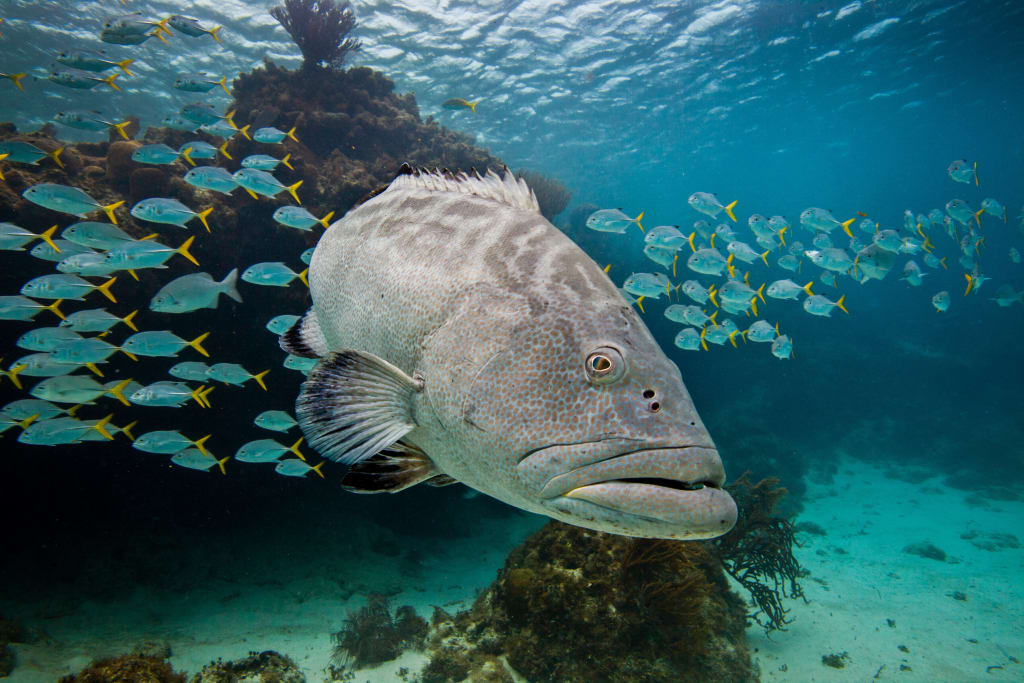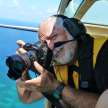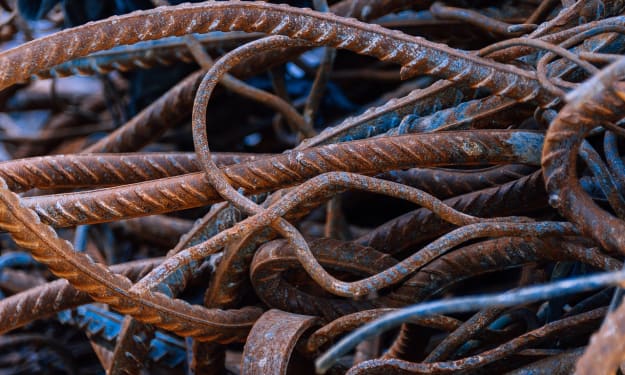Black Grouper at Hol Chan
As I approach, a school of yellowtail jacks streams by to serve as a background. The grouper turns in profile as if presenting his best side for a portrait. I oblige.

View print sizes for Black Grouper at Hol Chan by Tony Rath:
Story Behind the Photograph: Black Grouper at Hol Chan
Filming underwater is a completely different beast than landscape photography for the simple reason that salt, water and electronics do not mix. Once placed in the waterproof housing, the camera is untouchable for the entire dive, so there is a checklist I carefully work through before each dive.
Camera battery fully charged - check.
Lens crystal clean - check.
Install and format memory cards - check.
O-rings, which seal the housing, lightly greased and scanned for specks of dust (a sand grain will flood the housing and destroy camera and lens) - check.
The bubble dome through which the lens “sees” must be so clear that it is invisible to the camera - check.
Shutter, aperture and focus controls tested - check.
I then place the whole rig into a padded bag for protection against bumpy seas.
Now that my camera’s life support system is in place, donning my own life support is next. This time it is a mental checklist I run through. Attach regulator to a steel tank with 3000psi of filtered air inside; buckle a series of flotation tubes inside a nylon jacket to the tank and adjust on my back; test the regulator for proper airflow; check the gauges and computers which will monitor my depth, time and nitrogen absorption. Last to strap on are mask, fins and 12lbs of lead that will allow me to submerge beneath the waves. As I sit on the edge of the boat, and put the regulator in my mouth I do a final check on camera and my life support systems and back flip into weightlessness. No one ever said visiting paradise was easy, and underwater Belize is truly a paradise.
The Belize Barrier Reef Reserve System (BBRRS), inscribed as a UNESCO World Heritage Site in 1996, is comprised of seven protected areas; Bacalar Chico National Park and Marine Reserve, Blue Hole Natural Monument, Half Moon Caye Natural Monument, South Water Caye Marine Reserve, Glover’s Reef Marine Reserve, Laughing Bird Caye National Park and Sapodilla Cayes Marine Reserve. It is the largest reef complex in the Atlantic-Caribbean region and represents the second largest reef system in the world.
The unique array of reef types within one self-contained area distinguishes the BBRRS from other reef systems. The site is one of the most pristine reef ecosystems in the Western Hemisphere and was referred to ‘as the most remarkable reef in the West Indies’ by Charles Darwin.
Today I am exploring Belize's oldest marine reserve, the Hol Chan Marine Reserve. The name ‘Hol Chan’ is Mayan for 'little channel’ which is appropriate since the reserve focuses on a cut through the reef (called a quebrada) which is little more than 25 yards (23 m) wide and 30 feet (9 m) deep, about 4 miles southeast of San Pedro. The reserve was formed primarily as a community-based initiative due to concern over the high level of uncontrolled, often destructive, fishing and diving activities in the area. The entire reserve covers approximately three square miles (7.8 sq km) and is divided into four zones: mangroves, seagrass beds, coral reef, and Shark Ray Alley - a location where nurse sharks and southern sting rays congregate.
In the nearly 35 years of its existence, the Hol Chan Marine Reserve has become a paradise for marine life as well as for SCUBA divers and underwater photographers. As I swim over the seagrass beds towards the coral, rays and nurse sharks swarm, turtles feed and packs of hunting jacks cruise through clouds of bait fish. As I sink deeper into the channel, massive schools of snapper and jacks swim past.
In the distance I spy it. One of the largest black groupers I have ever seen. Outside of the reserve, grouper are a delicacy and will bolt out of speargun range at the first hint of a diver. But here, now, he holds his ground, not fearing the bubble-blowing creature with a big black box. As I approach, a school of yellowtail jacks streams by to serve as a background. The grouper turns in profile as if presenting his best side for a portrait. I oblige.
About Untamed Photographer
Untamed Photographer is an online art gallery that brings together wildlife photography and stories from a range of international environmental artists, both emerging and established.
Structured as an online marketplace, Untamed Photographer offers a selection of handpicked, limited-edition works of art, alongside the photographers’ compelling stories of what occurred in the wild to get the shot. The exclusive limited-edition pieces are printed in Miami and come with an artist-signed certificate of authenticity from their respective worldwide locations.
The Nature Trust of the Americas (NTOTA) was founded with the mission to give back. While building awareness for NTOTA’s causes, the founders met talented nature photographers who are passionate not only about photography, but also about saving the planet. Their life’s work and stories are inspiring, and their art, passion and stories deserve to be shared on a platform that benefits the environmental causes they are dedicated to.
Just as the photographers preserve the beauty of the planet in their art, Untamed Photographer is dedicated to preserving the planet for the future. All profits from photographs go to Untamed Photographer's two pillars: the artists and causes that protect the environment, ecosystems, and wildlife.
About the Photographer: Tony Rath
Tony Rath is a writer, photojournalist and commercial photographer based along the Caribbean Sea in the picturesque village of Dangriga, Belize.
Tony attended the United States Air Force Academy, where he flew gliders above the Rocky Mountains and trained with Navy SEALS in San Diego. After leaving the military he studied toward a marine biology degree, working as a technician, diver, and underwater photographer for Scripps Institution of Oceanography and the Smithsonian Institution’s Marine Research Station in Belize.
At age 23, Tony took early retirement and for 7 years sailed as either first mate or captain across the Atlantic (twice), Mediterranean, North Sea and the Caribbean. While sailing, he visited over 35 countries, more than 250 ports of call, and sailed over 30,000 miles. Throughout his adventures, Tony always carried a camera, turning professional in the mid-1990s.
Tony's photography is on display at the Smithsonian Institution in Washington, D.C. and featured in the Minnesota Science Museum’s award-winning traveling Maya exhibit. His images have been published in hundreds of magazines and books, such as BBC Wildlife, National Geographic Traveler, Islands, and Smithsonian Magazine. Tony's clients include the United Nations, Government of Belize, and many international environmental NGOs.
Living in Belize since 1988, he documents the natural environment and cultures of his adopted country, above and below water. He has published two photo books on Belize.
Tony volunteers his skills and imagery to countless educational and NGOs to promote culture and conservation. In 2015 he presented one of the first TEDx Talks in Belize.
While known for his natural history imagery, he also covers lifestyle, travel, portraits and culture throughout Belize and neighboring countries.
About the Creator
Tony Rath
Tony Rath is a writer photojournalist based along the shore of the Caribbean Sea in the picturesque town of Dangriga, Belize.
http://www.tonyrath.com
Facebook: BelizePhotography
Twitter: trphoto
Instagram: tonyrath
Enjoyed the story? Support the Creator.
Subscribe for free to receive all their stories in your feed. You could also pledge your support or give them a one-off tip, letting them know you appreciate their work.







Comments
There are no comments for this story
Be the first to respond and start the conversation.